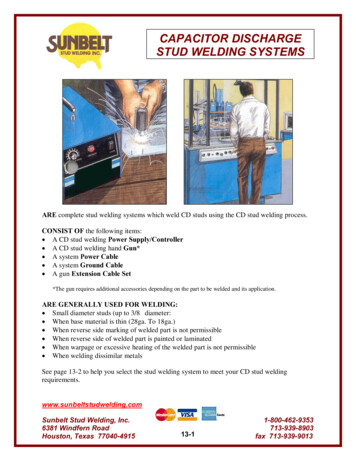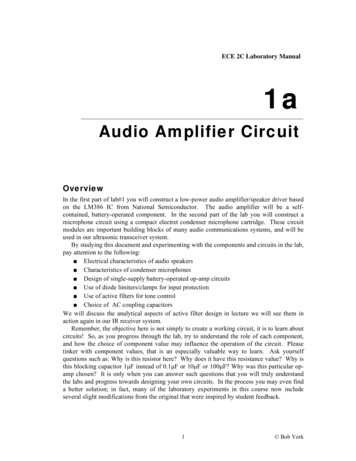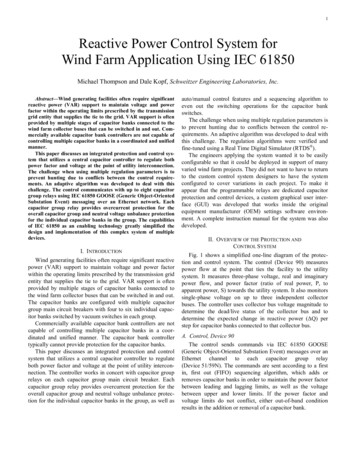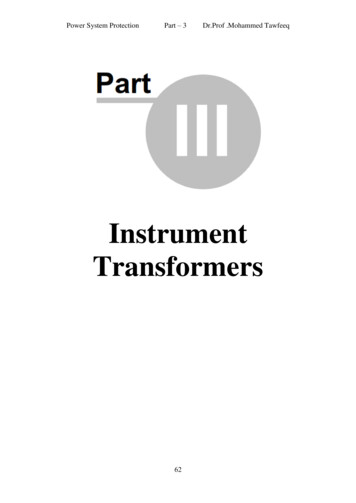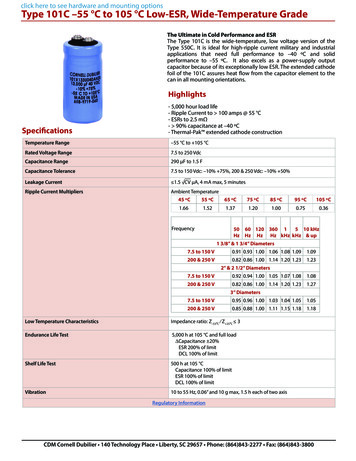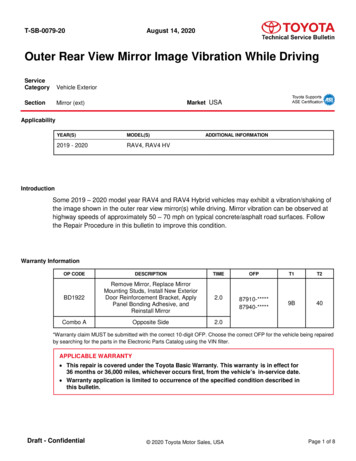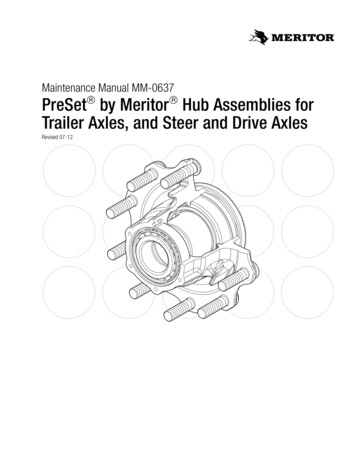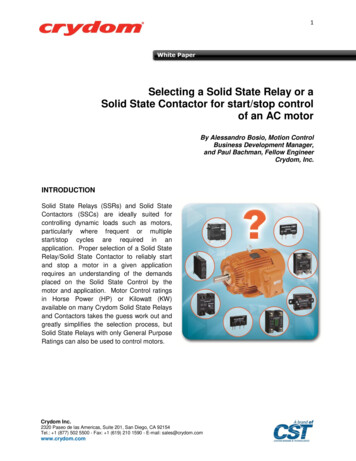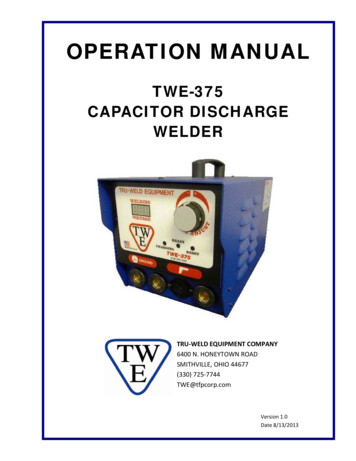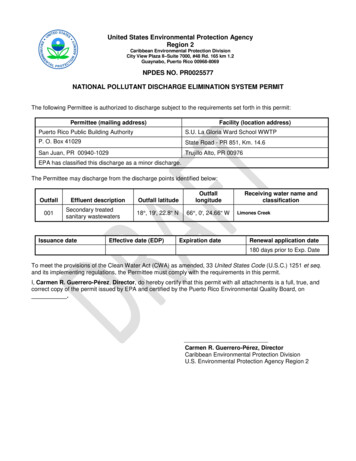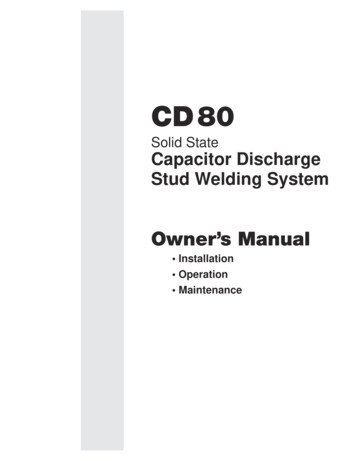
Transcription
CD 80Solid StateCapacitor DischargeStud Welding SystemOwner’s Manual Installation Operation MaintenanceCD 50 Stud Welder0
2001 MIDWEST FASTENERS, INC., all rights reserved.450 Richard StreetMiamisburg, OH 45342Phone: (800) 852-8352Fax:(937) 866-41740CD 50 Stud Welder
TABLE OF CONTENTSGENERALWarranty . 4Safety Precautions . 5INTRODUCTION What is Stud Welding ? . 6How Does CD Stud Welding Differ From ARC Stud Welding ? . 6CD 80 Overview . 8INSTALLATIONCD 80 Installation . 9SETUP& OPERATIONCD 80 Setup . 10Gun Set UpsInsulation Pins . 11Insulation Pins with Collet Protector . 11Weld Studs . 12Weld Studs with Template Adaptor . 12Controller Adjustment . 13Making A Test Weld . 13Weld Quality . 14Preventive Maintenance . hooting . 15CD 80 Welder Specifications . 18CD 80 Welder Exploded View & Parts List . 19CD 2P Gun Specifications . 20CD 2P Gun Exploded View & Parts List . 21CD 80 Electrical Schematic . 22Notes . 23
WARRANTYAll parts used in the assembly of your MIDWEST FASTENERS StudWelding System are fully guaranteed for Ninety (90) days from deliverydate. In addition, the Welding Capacitors are fully guaranteed for a periodof One Hundred and Twenty (120) days from delivery date.Under this warranty, MIDWEST FASTENERS reserves the right to repairor replace, at its option, defects in material or workmanship which occurduring the warranty period. Notice of any claim for warranty repair mustbe furnished to MIDWEST FASTENERS within ten (10) days after thedefect is discovered. MIDWEST FASTENERS does not assume liabilityfor shipping, or liability for any labor or material related to use of thissystem unless such costs are expressly authorized in writing by MIDWESTFASTENERS.MIDWEST FASTENERS, INC. does not warrant defects in welders, partsor accessories resulting, from abuse, improper installation, or for reasonsbeyond its control.This warranty is valid only when welding pins and/or studs approved by orpurchased from MIDWEST FASTENERS.MODEL NO.SERIAL NO.SHIPPING DATEVOLTAGE REQUIRED4 2001 MIDWEST FASTENERS, INC. — CD 80 Stud Welder
SAFETYPRECAUTIONS Comply with all electrical, fire and other applicable codes or ordinancesin the installation and use of stud welding systems. Remove all combustible or volatile materials from the weld area.Although weld splatter resulting from stud welding is normally minimal,proper precautions should be taken when welding near or throughcombustible materials to insure that sparks or weld material do not comein contact with combustible material. Recommend wearing of eye protection at all times when welding.Spectacle type frames with Shade No. 3 absorptive and filter lens andside shields are suggested. Never look directly at the weld arc withoutwearing eye shields. Recommend use of proper ear protection with all CAPACITORDISCHARGE stud welding systems. The stud welding operator andanyone working within five (5) feet of the stud welding operation shoulduse ear protection devices.EYEPROTECTION Use of protective clothing is suggested. Type of clothing will vary as toapplication, weld position and stud welding being used; however, in allcases, it should be fire resistant and sufficient to protect weldingoperator from weld splatter and material. Keep hands, clothing, etc. away from the weld stud, chuck and all otherparts in contact with them during the weld cycle.HEARINGPROTECTION Keep weld cable and connectors in good condition. Inspect periodicallyfor broken insulation and/or other electrical hazards. Do not operate with worn or poorly connected cables. Inspect all cablesoften for bare or exposed wires, broken insulation layers and/or looseconnections. Repair all such connections before welding use.HIGH VOLTAGE Do not stand in water or on damp surfaces while welding. Avoid wearingwet or sweaty clothes. Do not weld in the rain.WARNINGUse extreme caution when servicing or troubleshootingany component of this stud welding system.If possible, turn all power controls “OFF”and disconnect all electrical cables.For other suggested precautions, safe practices, etc.regarding welding, refer to“Safety in Welding and Cutting”,ANSI Z49.1, American National Standards Institute. 2001 MIDWEST FASTENERS, INC. — CD 80 Stud Welder5
WHAT IS STUDWELDING ?Stud welding is a welding process where a “stud” (or similar metal part) isinstantaneously end-joined to a metal workpiece. This process involves thesame basic principles and metallurgical aspects as any other weldingprocess.The equipment required to stud weld is composed of a direct current powersupply, a controller, a weld gun and cables to tie the system componentstogether. In most systems the power supply and controller are combined intoone unit called the “Welder.”CD 80 STUD WELDING SYSTEM (P/N: CDSW-080-01)ControllerCDSW-080-00ONERPOWELTAGD VOWELWeld GunCDPG-200-06XMAEMIN LTAGVOOFFCD 8NGU–0LNTROCOCD GRNDOUBLECAGround CableCDGC-201-15The stud welding process is as follows. The stud is placed in the collet of the“Weld Gun” and then positioned against the workpiece. The weld gun triggeris depressed and through operation of the stud welding controller and thedesign of the stud, an arc is drawn which melts the base of the stud and aproportionate area of the workpiece. The stud is then forced by the weld guninto the molten pool and held in place until the metals resolidify. This highquality fusion weld is completed in milliseconds.HOW DOESCD STUD WELDINGDIFFER FROMARC STUD WELDING ?There are two different stud welding processes: Capacitor Discharge (called “CD” for brevity) and Arc.The difference between these two methods involves the power source usedto provide the welding current, the workpiece size, base material and thestud design.6 2001 MIDWEST FASTENERS, INC. — CD 80 Stud Welder
CD STUD WELDINGThe CD stud welding process produces weld power through a rapiddischarge of the stored energy from a bank of capacitors. This storedenergy is usually derived from a standard 115 volt AC source. CD studwelding, as a general rule, is used for studs 5/16" and less in diameter,(or where thin base metals or dissimilar metals are to be joined.)“CD” STUD WELDING PROCESSARC STUD WELDING1. Stud is placed against workpieceand weld gun trigger depressed2. Stored energy is dischargedthrough special tip3. Weld gun forces studinto molten metal4. Weld solidifies inmilisecondsThe ARC stud welding process produces weld power through one of threestandard DC welding power sources. These are Transformer-Rectifier type,Motor/ Generator type, or Storage Battery type. A ceramic ferrule isrequired in ARC stud welding to maintain the proper atmosphere in theweld area. ARC stud welding is generally used for studs over 1/4" indiameter or where heavier base metals are involved.“ARC” STUD WELDING PROCESS1. Stud is placed against workpieceand weld gun trigger depressed2. Stud is lifted by weld gunand initiating arc is drawn3. Weld gun forces studinto molten metal4. Weld solidifies andferrule is removed 2001 MIDWEST FASTENERS, INC. — CD 80 Stud Welder7
OVERVIEW – CD 80CAPACITOR DISCHARGESTUD WELDERThe CD 80 is a capacitor discharge stud welder. The weld energy is storedin capacitors located inside the control unit. The amount of stored energycan be controlled by rotating the voltage control knob located on the frontpanel.CD weld studs, or pins, used with the CD 80 must have a speciallydesigned projection at the weld end. When the stud is inserted into the weldgun and placed against the workpiece, and the trigger switch is depressed,the following occurs:1. The energy stored in the capacitors travels through the weld cables tothe stud.2. The rapid rise in current ignites the projection and allows a weldingarc to be established between the stud and the workpiece.3. The arc melts the base of the stud and a portion of the workpiece.4. The spring pressure inside the welding gun forces the stud into themolten metal pool created by the arc.5. The cycle ends upon contact of the stud to the workpiece.6. The welding gun is then removed. Upon removal, the controller willautomatically recharge to the set voltage.CAUTIONThe noise generated by stud weldingmay exceed allowable levelsestablished by O.S.H.A. For this reasonit is recommended that proper ear protection be wornby the operator and anyone working in the immediate area.HEARINGPROTECTIONWARNINGVoltages inside the unit can reach 200 volts D.C.even if the unit is turned off. All repair workshould be handled by factory trained personnel.HIGH VOLTAGE8 2001 MIDWEST FASTENERS, INC. — CD 80 Stud Welder
CD 80 INSTALLATIONFollow the process below to properly install your CD 80 stud welder.CD 80 Cable eGROUND CABLENOTE: All cables should belaid out straight or in large loops.Poor welds may result ifwelding cables are closelycoiled or stacked up.1. Carefully remove the controller, cables and weld gun from theshipping packaging.2. Set the Controller on a clean, dry, sturdy surface near an appropriatevoltage supply and the workpiece.3. Connect the Ground Cable male cam-lok connector to the controllerconnector marked “CD / GROUND CABLE.”4. Clamp the Ground Cable C-clamp firmly to a clean (free from paint,rust, scale, grease or oil) area on the workpiece.5. Connect the Gun Cable male cam-lok connector to the Controllerreceptacle marked “GUN.”6. Connect the Gun Cable control connector to the Controllerreceptacle marked “CONTROL.”7. Plug the Controller Power Cord to appropriate power source. 2001 MIDWEST FASTENERS, INC. — CD 80 Stud Welder9
CD 80 SETUPAfter installation, two setup phases must be completed before welding canbegin. These phases are: Weld Gun Setup, and Controller Adjustment.WELD GUN SETUPYour weld gun setup will depend on your application and the particularstud to be welded. Setting up the gun consists of the following:1. Locate the studs (or pins) that were shipped for your job and place astud into the weld gun Collet with the “weld tip” protruding. Push thisstud in until it seats firmly, assuring that the flange (or collar) of theweld end does not come into contact with the collet.2. Make sure that the gun “setup” accessories that came with the CD 2Pweld gun are adjusted properly and fastened tightly. Illustrations onthe following pages for: Insulation Pins (Figure 1) Insulation Pins with Collet Protector (Figure 2) Weld Studs (Figure 3) Weld Studs with Template Adaptor (Figure 4)NOTE: These components may need to be readjusted, or changed, asyour job requirements change.10 2001 MIDWEST FASTENERS, INC. — CD 80 Stud Welder
CD-2P WELD GUNSETUPINSULATION PINS eld(Optional)WeldPin1/8"- 3/16" Protrusion1. Seat weld pin firmly against stop.2. Loosen these adjustment screws.3. Slide the Leg / Foot assembly untilweld pin flange extends 1/8"- 3/16"beyond foot (or spark shield.)4. Retighten adjustment screw.(Fig.1)CD-2P WELD GUNSETUPINSULATION PINS .AdjustableLeg / let(insideProtector)WITH .ColletProtectorInsertWeldPinCOLLET PROTECTOR .1/8"- 3/16" Protrusion1. If “B” Stop is used, seat weld pin firmlyagainst stop.2. Loosen these adjustment screws.3. Slide the Leg / Foot assembly untilweld pin flange extends 1/8"- 3/16"beyond foot (or spark shield.)4. Retighten adjustment screw.(Fig.2) 2001 MIDWEST FASTENERS, INC. — CD 80 Stud Welder11
CD-2P WELD GUNSETUPAdjustableLegWELD STUDS .“B”Collet“B”StopFootWeldStud1/8"- 3/16" Protrusion1. Seat weld pin firmly against “B” stop.2. Loosen these adjustment screws.3. Slide the Leg/ Foot assembly untilweld stud flange extends 1/8"- 3/16"beyond foot.4. Retighten adjustment screw.CD-2P WELD GUNSETUPWELD STUDS .WITH .(Fig.3)TEMPLATE ADAPTOR eldStudWorkPiecePositioningTemplateWeld Gun withTemplateAdaptorFaceplate1/8"- 3/16"ProtrusionTemplate Adaptors are usedwhen precise positioning ofthe stud is required.(Fig.4)12 2001 MIDWEST FASTENERS, INC. — CD 80 Stud Welder
CD 80 SETUP CONTROLLERADJUSTMENT&MAKING A TEST WELDAfter verifying that the welding system is installed and your weld gun issetup properly for your application, the final step is to adjust your studwelding controller to the proper settings.1. (Before turning on power) turn the controller VOLTAGE selectorswitch to “MIN” (fully counterclockwise.)2. Turn the controller ON/ OFF switch to “ON.” Verify by observing“POWER” lamp.3. Using the chart below, adjust the “VOLTAGE” control until the“WELD VOLTAGE” meter reads the desired value.The chart settings shown below are "reference" settings to be used asstarting points. Actual voltage settings may vary depending upon theconditions or each application and use. The voltages shown also assumethat the following are in use (as described in previous Installation andSetup sections of this manual.)A) Straight polarity cable set ups in use (Gun Negative, Ground Positive.)B) Ground connection directly to the part to be welded and connected ina clean, solid manner.C) 1/8" protrusion of pin/stud onto work (3/16" for Aluminum) causingan equal amount of spring pressure in the gun.D) “Silver” gun spring for Mild or Stainless Steel, “Black” forAluminum applications.E) Good, clean accessories and work surface to be welded, with proper setup ofall accessories.Pin/Stud TypeInsulation PinWeld Studs(Flanged)Pin/Stud DiaPin/Stud Mat’l.Voltage Setting12 GA10 GAMild Steelor Stainless90 -100100 -11012 GA10 GAAluminum120 -130135 -145#10 or 3/16"1/4"5/16"Mild Steelor Stainless125 -135155 -165165-175#8#10 or 3/16"1/4"Aluminum130 -140140 -150150-160NOTE: Be sure that proper observation of all safety precautionsare in place before performing the next step.4. Pick up the weld gun and place the stud firmly against the workpiece(The test workpiece should be a material that is similar to theworkpiece to be welded to in actual production.) 2001 MIDWEST FASTENERS, INC. — CD 80 Stud Welder13
5. Depress the weld gun trigger, wait momentarily, and then pull the gunstraight back off the stud.6. Test the weld integrity (see below.)WELD QUALITYStud Welded Joint QualityGOODHOTCOLDEven weldfilletall aroundExcessive splatterandthin weld filletLittle orno weldfillet A GOOD weld is determined by bending the stud back and forth.Failure should occur in the stud shank or workpiece, not in the weld. HOT weld shows excessive splatter — adjust voltage downward(see 6. A. below). COLD weld shows little or no splatter and may have a voidbetween the stud and workpiece — adjust voltage upwards.(see 6. B. below).6. Adjust the weld voltage up or down until a satisfactory weld isconsistently achieved.If you need assistancewith setup, or operation, callMIDWEST FASTENERSTechnical Support at(800) 852-8352Monday through Fridaybetween 8am and 5pmEastern time.A. When adjusting voltage downward, (e.g. from 100 V to 80 V) itis necessary to turn the power off. Then turn the voltage selectorknob counterclockwise, turn the power back on, and increase tothe required voltage.B. To adjust the voltage upwards (increase weld heat), turn thevoltage selector knob clockwise in small increments to a highersetting.When weld quality is consistently satisfactory, the CD 80 is properlyinstalled and setup.14 2001 MIDWEST FASTENERS, INC. — CD 80 Stud Welder
PREVENTIVEMAINTENANCEYour MIDWEST FASTENERS welder is designed for long service withminimal care. Ordinary common sense maintenance will keep it operatingefficiently. The following are a few tips on preventive maintenance.1. Treat the cables with respect. Avoid sharp bends or kinks which maybreak the cables. DO NOT use the cables as a “ towline” to drag or liftthe controller. Avoid damaging or straining the cables where theyenter the gun or controller.2. Louvers on the sides of the controller should be free fromobstructions at all times to prevent overheating.3. Keep the controller and gun clean and dry, free of grease, water, dustand dirt. Do not lubricate any part of your CD 2P weld gun.4. The weld gun is for welding studs only. Do not use the weld gun as amultipurpose tool (i.e., Hammer—banging studs to test welds orbreak ferrules, Scraper—removing rust, scale or weld splatter, etc.)TROUBLESHOOTINGWhen troubleshooting the CD 80, the following precautions must beobserved.1. Controller power must be TURNED OFF!NOTE: Dangerous voltage levels can still be present in thecontroller—even after power is disconnected.2. The use of a volt/ohmmeter is recommended to verify where anyvoltage may, or may not, be present.HIGH VOLTAGE3. The use of a continuity tester (or trouble shooting light) can be usedfor continuity checking (disconnected) cables only.The troubleshooting chart on the following pages can assist in locating andfixing problems with the CD 80. 2001 MIDWEST FASTENERS, INC. — CD 80 Stud Welder15
TROUBLESHOOTING CHARTPROBLEM1. Welder does not turn onand will not weld.2. Circuit Breaker trips orfuse blows each time thecontroller is turned on orfuse blows.3. Circuit Breaker trips orfuse blows when weld ismade.4. Welder powers on, butdoes not operate.16POSSIBLE CAUSECORRECTIVE ACTIONA. Power cable connection atcontroller or 115 VAC outlet notcomplete.Inspect power cable connection.Repair if loose.B. Power cable/connectordamaged.Check for continuity. Repair breakor replace connector.C. Open circuit breaker, fuse ordamaged wall outlet.Check with ohmmeter. Replacedefective part (Fuse BUSSMDA20, or equivalent.)A. Shorted weld capacitor.Check capacitors safety vent seal forrupture hole. Replace defectivecapacitor.B. Shorted rectifier.Check with ohmmeter. Replacerectifier if defective.C. Faulty circuit breaker.Check with ohmmeter. Replacerectifier if defective.D. Shorted transformer.Remove two orange wires fromcharge rectifier. If fuse continues toblow, replace transformer.A. Shorted charge SCR.Check with ohmmeter. (Should notshow continuity in either direction.)Replace if defective.B. Faulty printed circuit (PC) board.Replace with new PC board if defective.A. Ground cable or gun cableconnections not complete.Check for continuity and properconnection of ground to workpiece.B. Broken gun control cable orloose wire connection in plug.Check continuity between pins “ ”and “Z” of plug while depressinggun trigger. Should read continuityonly when depressed.C. Shorted gun control wires at thegun trigger switch.Check continuity between pins “ ”& “Z” of plug. No reading shouldbe observed while gun trigger is inthe released position.D. Faulty printed circuit board.Replace with new PC board if defective. 2001 MIDWEST FASTENERS, INC. — CD 80 Stud Welder
TROUBLESHOOTING CHARTPROBLEM4. Welder powers on, butdoes not operate.POSSIBLE CAUSEE. Shorted weld SCR.Unplug PC Board and checkcontinuity between SCR heat sinkand negative (–) buss bar. No readingshould be observed. Replace SCR ifcontinuity exists.A. Shorted charge SCR.Check continuity across SCR. Noreading should be observed in eitherdirection. Replace charge SCR ifcontinuity exists.B. Faulty printed circuit board.Replace with new PC board if defective.C. Open voltage potentiometer.Replace defective voltagepotentiometer.A. Improper gun setup.Check gun for proper setup (see page 10).B. Improper grounding, cableinstallation or incorrect polarity.Check grounding and cable installationfor proper setup (see page 9).C. Weld cables coiled.Straighten out cables or place inrandom loops.D. Incorrect weld voltage setting.Adjust as necessary (see page 13).E. Studs (or Pins) notperpendicular to workpiece.Adjust gun set up as necessary. Replacebent or defective legs (see page 10).F. Faulty printed circuit board.Replace with new PC board if defective.(continued)5. Weld is excessively hotregardless of voltagesetting.6. Consistently poor orerratic welds.CORRECTIVE ACTIONIf you need assistancewith setup, or operation, callMIDWEST FASTENERSTechnical Support at(800) 852-8352Monday through Fridaybetween 8am and 5pmEastern time. 2001 MIDWEST FASTENERS, INC. — CD 80 Stud Welder17
CD 80STUD WELDING SYSTEMSPECIFICATIONS9 "18 ON"ERPOWETAGVOLLDWEXMAEMIN LTAGVO8 "OFF0CD 8NGU–OLNTRCOCD BLECANDOUGRWeight . 58 poundsPower Requirement . 115 VAC, 60 Hz, 20 AmpPin/Stud Range . 14 ga. – 5/16" dia.Weldable Materials . Mild Steel, Stainless,Brass & AluminumWeld Mode. ContactWeld Rate . 20 /minute (maximum)*(* Dependent on stud size.)Weld Voltage . 35–175 VDCCapacitance . 98,000 mfdCables . 15' Ground Cable25' Extension Set18 2001 MIDWEST FASTENERS, INC. — CD 80 Stud Welder
CD 80STUD WELDING SYSTEMEXPLODED VIEWDIAGRAMItem 9394041424344 2001 MIDWEST FASTENERS, INC. — CD 80 Stud 121211122221Part criptionCabinet HandleSheet Metal Cover#10 x 3/8 Sheet Metal ScrewsVoltage Control KnobPanel MeterVoltage Control PotentiometerPower Indicator LightPower Circuit Breaker SwitchFuse HolderFuse - 25A (Not shown)Internal Weld Cable10-32 x 5/8 Pan Head Screw#10 Split Lock Washer1/4-20 x 1/2 Hex Head Bolt1/4 Split Lock WasherBuss Bar - FBuss Bar - GBuss Bar - DBuss Bar - CPower CordWeld CapacitorBleed ResistorSafety Switch BracketResistor BracketBallast ResistorCabinet Safety SwitchSnubber CapacitorHold Down Rod1/4-20 Hex Nut1/4 nylon Shoulder BushingCable Grommet - ACCapacitor InsulatorSheet Metal BasePC Board BracketWiring Harness AssemblyPC Board AssemblyMain TransformerPC Board ClampTerminal StripFuse HolderControl RelayFuse 1ACharge SCR1/4 nylon Shoulder BushingCharge Bridge RectifierCamlok Connector ReceptacleControl Connector Receptacle (PM-F)SCR Heat Sink BracketMain SCR1/4-20 x 3/4 Hex Head Bolt1/4 Split Lock Washer1/4 Flat Washer1/4-20 Hex NutData Plate (Not shown)19
CD 2PSTUD WELDING GUNSPECIFICATIONSWeight . 1-1/2 pounds(not including cables)Pin/Stud Range . 14 ga. – 5/16" dia.Weldable Materials . Mild Steel, Stainless,Brass & AluminumMaterial . High strength, impactresistant, polycarbonateCable Length . 6'20 2001 MIDWEST FASTENERS, INC. — CD 80 Stud Welder
CD 2P STUD WELDING GUNEXPLODED VIEW DIAGRAM& PARTS 2232241Item 11211231211Part 0101-0801-01060-3222-07060-3222-06DescriptionMale Control ConnectorMale Weld ConnectorRear Body CapSpring Retaining Plate10-32 x 5/8 Pan Head ScrewShaft Spring (Black)Spring Retainer Plug (Prec.)Right Gun Body Half, PrecisionShaft Tube Bearing - Rear10-32 x 5/8 Soc Head Screw10-32 x 3/16 Set screwGun Shaft10-32 x 3/16 Set ScrewFront Shaft BearingStandard Faceplate10-32 x 3/16 Set Screw8-32 x 3/4 Soc Head ScrewShaft BootWeld Gun Leg 7"Boot RetainerBoot Retainer Split Ring 2001 MIDWEST FASTENERS, INC. — CD 80 Stud WelderItem Qt’y.222324252627282930311221111111Part 33060-3003-00050-1005-35Weld Gun Foot#10 Flat Washer10-32 x 5/8 Soc Head ScrewControl CableRubber Cable Sleeve, SmallWeld Cable AssemblyTrigger Micro SwitchLeft Gun Body Half, PrecisionTrigger Button SpringTrigger Not ShownShaft Spring (Silver)Shaft Spring (Gold)Shaft Spring (Copper)Shaft Spring (Red)21
115 / 220VACF122CRR220VAC110VAC110VACA– 150VAC24VACAF25KΩ25WIPL3IPL10IPL 8IPL 5CBVMIPL 725KΩ50Ω50WCRCRCabinet SwitchC1-7IPL1060-3081-01Rev. 1P.C. BoardIPL 4IPL9IPL2IPL6 GunTriggerGunWork (CD)CD 80STUDWELDINGSYSTEMELECTRICALSCHEMATIC 2001 MIDWEST FASTENERS, INC. — CD 80 Stud Welder
NOTES 2001 MIDWEST FASTENERS, INC. — CD 80 Stud Welder23
DISCHARGE stud welding systems. The stud welding operator and anyone working within five (5) feet of the stud welding operation should use ear protection devices. Use of protective clothing is suggested. Type of clothing will vary as to application, weld position and stud welding being used; however, in all cases, it should be fire resistant .
